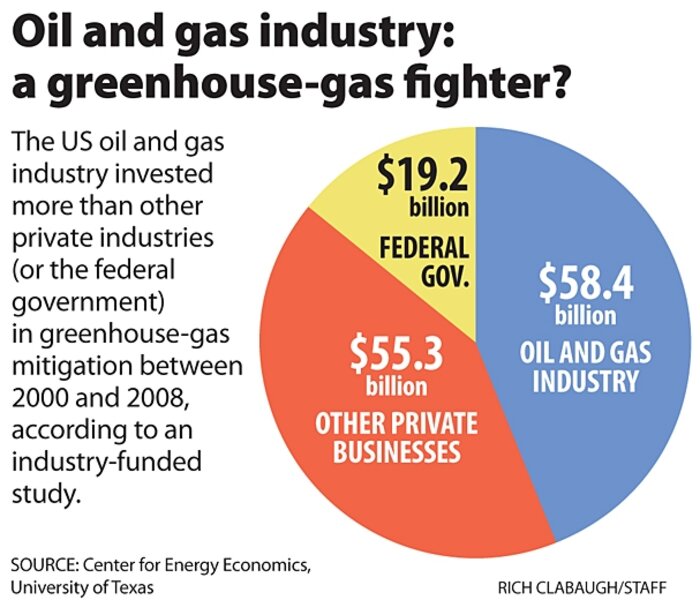Is Big Oil a crusader against greenhouse gases?
Loading...
| New York
Over the past eight years, which industry has invested the most to mitigate the effects of greenhouse gases?
You might be thinking of windmills or solar panels. Or maybe those folks who are trying to make energy out of pond scum ... er, algae. But according to a new industry-funded study (.pdf) out on Monday, the oil and gas industry significantly leads all other sectors, including the federal government.
Between 2000 and 2008, the Exxon-Mobils of the world spent $58.4 billion on such things as fuel substitution, energy efficiency projects, and new nonpolluting ways to produce energy, the study found. By way of contrast, the rest of North American business spent $55.3 billion in the same time period and the federal government spent $19.2 billion.
Where did the money go?
The largest investments went to advanced technology vehicles (28 percent), energy efficiency (14 percent), cogeneration of heat and power (11 percent), and ethanol (10 percent).
Did all those investments make any difference?
This is hard to say because, according to the Energy Information Administration, the US production of greenhouse gases dropped by 2.8 percent last year.
Who can forget 2008? Gasoline peaked at over $4 a gallon and the price of a barrel of oil zoomed to $147 a barrel. Oil was so expensive, alternatives such as hydrogen and solar began to look attractive.
The decline in greenhouse gas emissions took place just as the world was starting to go into an economic tailspin. Growth in GDP in 2008 was about 1.1 percent, according to the report, while energy demand fell 2.2 percent. Carbon dioxide intensity, that is the measurement of CO2 per unit of gross domestic product, improved by 3.8 percent in 2008.
Acknowledging those factors, the study also concluded that mitigation investments played a role.
Why emissions fell
The EIA, on its website, says the main reasons for the decline in emissions were higher energy prices and lower economic growth. With business hobbled, demand for electricity was lower.
According to the EIA, the leading producers of CO2 are petroleum, natural gas, and coal. So, if the basic information on the report is correct, it might offer some hope that the largest polluters are trying to find environmentally-correct alternatives.
But don’t get your hopes up. The EIA estimates energy consumption in the US will rise 9 percent between 2007 and 2030. As the new reports notes, “This increase is projected after accounting for a predicted improvement in energy intensity (energy usage per real dollar of GDP).”
And where will the US get its future energy supply? The EIA estimates the market share of oil, natural gas, and coal will be 79 percent by 2030. This is down from 84 percent in 2007. Will that reduce green house gas emissions enough? Stay tuned.
One additional word about the study: It was funded by the friendly folks at the American Petroleum Institute who also funded an earlier report two years ago. The authors of this report are Thomas Tanton, president of T Squared & Associates and the Center for Energy Economics at the University of Texas. Mr. Tanton is a former environmental fellow at the Pacific Research Institute, a San Francisco group, that espouses free markets and receives some of its funding from tobacco and energy companies. The UT center, according to its website, focuses on “commercially viable energy projects” and helps prepare students to work in the industry.
– Guest blogger Ron Scherer is a Monitor staff writer.



